We do not know for sure the exact place of origin of shield and a sword combat system found on Okinawa today. The legend says this weapon was used in the past wars during the period of “three kingdoms” (the fourteenth century). Nowadays, various shapes of this weapon can be found on Okinawa. Objects and tools such as harpoon, dagger or a machete, straw hat or a suitable metal plate are of a great use, since they are impercep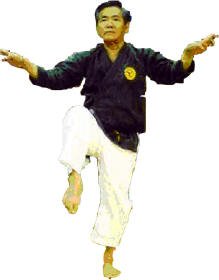 tible and used for everyday labor as well. Turtle armor was often used as a shield, too. In the past, metal was extremely rare and expensive, but the okinawan beaches had many big turtles, so their armor was perfect for making shields. There are several traditions involving this weapon, but application principles are alike. Technique differences are due to the form of the shield and the sword.
tible and used for everyday labor as well. Turtle armor was often used as a shield, too. In the past, metal was extremely rare and expensive, but the okinawan beaches had many big turtles, so their armor was perfect for making shields. There are several traditions involving this weapon, but application principles are alike. Technique differences are due to the form of the shield and the sword.
On Okinawa today, a few schools cherish this weapon, whereas the tradition of Matayoshi family is the most active. Matayoshi Shinko, sensei, also known as “Kama Matayoshi” was born in Naha (Okinawa) in 1888. He is founder of the Matayoshi kobudo school. As a young boy, he learned bo-jitsu (the staff), eku-jitsu (oar), sai-jitsu (iron rod) and kama–jitsu (sickle) from master Agena Chukubo from the Gushikawa village. He also learned tonfa–jitsu (wand) and nunchaku-jitsu (mallet) from master Irei of Nozatoa (Chatan village).He traveled a lot with the purpose of expanding his knowledge. In Japan, he learned samurai horse riding. In Manchuria, he had spent much time with nomad tribes, where he practiced ba-jitsu (horse riding), shuriken-jitsu and nagenawa-jitsu (lasso throwing). In Shanghai, the master Kingai taught him tinbei-jitsu (a sword and a shield), suruchin-jitsu (lasso), nunti-jitsu (javelin) and use of the medicinal herbs and acupuncture as well. In the province of Fukien (China), he practiced Shorin chuan fa and finally, he returned to Okinawa in 1935.
In Shangai, Matayoshi completed his knowledge practicing in the legendary school Jing Voo. It is known that Chojun Mijagi (founder of Goju style) spent there a couple of months in 1936, practicing. (Patrick McCathy, Bubishi, page 60). Perhaps the technique of shield and sword was brought to Okinawa exactly from this Chinese combat school. Any way, in the present days Matayoshi tradition nourishes one form (kata) with a machete and a shield. The purpose of this article is to explain the basics (kihon) and the advanced technique of “Matayoshi no tinbei” form.
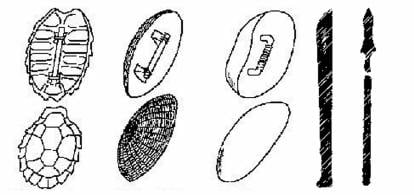
The picture shows the shield made of turtle’s armor, a straw shield, metal shield, the typical rochin of Matayoshi tradition and a short spear that is used by the Hozon tradition.
The basics (kihon)
The first thing one should learn about manipulating with machete and shield is proper guard (kamae). Guard is a position that provides good defense and a quick way to attack. Shield is held in the arm that is in front and it is used for parrying of the opponent’s attacks. Techniques of blocking are identical to the ones in karate. Machete is held in the arm that is in back ready for use and protected by shield so that the opponent cannot get a hold of it.
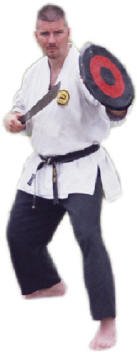
Guard – kamae
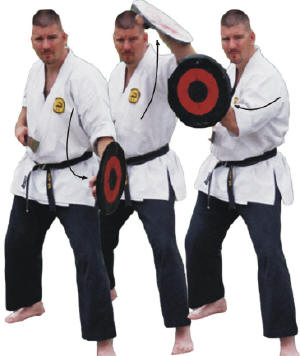
Blocking techniques – uke wasa
Knees are slightly bent and the weight is equally divided onto both feet. When moving, so called “spearman step” (yori ashi) is used. This one does not require a full step. The rear leg makes half a step, just a little in front of the leg that is at front, and then the front leg makes another half of the step. This method of stepping enables spearmen to have a hold so that weapon is always ready for use. Concerning Machete and shield, it is necessary to emphasize that a shield should always be in front hand. If a man made full steps, with each his step the position would change, so shield would alternatively be a little in the front hand, a little in the back hand.
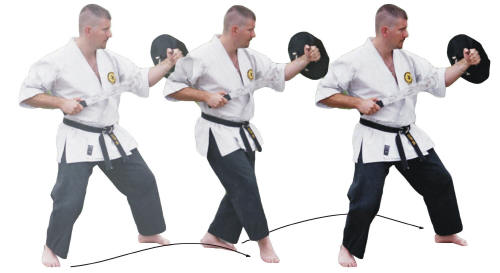
Machete and shield are in such position, so that the opponent cannot see machete due to shield. When using “yori ashi” for slow approaching to the enemy, this position can look very intimidating.
Stabbing and slashing (tsuki and uchi)
With machete, one can perform both stabbing (tsuki) and slashing (uchi). Stabbing techniques are aimed to the opponent’s stomach or neck. Slashing techniques (uchi) are equally practical for the attack and defense. In defense, machete parries each of the opponent’s attacks with blade. Offensively, limbs, neck or the opponent’s head are slashed.
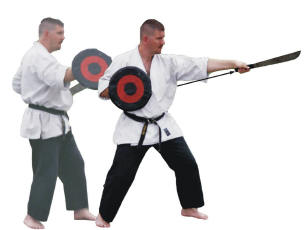
Tsuki – stab with machete is usually pointed towards body or neck of the attacker. According to the rule, stab is done by involving the whole body by performing full step, similar to oi tsuki in karate.
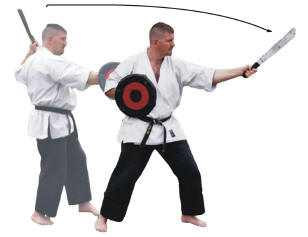
Soto uchi – outside slash. This one is for both defense and attack. In defense, blade is used for blocking the upper attacks (pointed towards the head or body). When attacking opponent’s hand, face or neck is slashed.
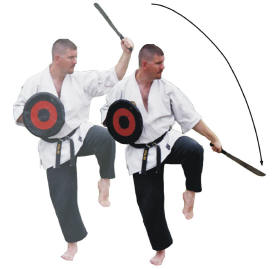
Gedan uchi – low slash. This blocking technique is used when the attacker strikes with the staff at legs or trying to stab the body.
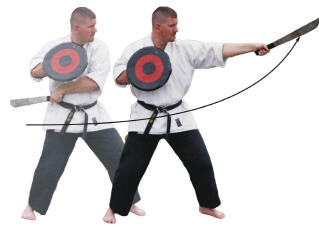
Uchi uchi – inside slash. Everything said for the previous technique stands for this one, too. The only difference is that here the stroke is performed on the inside.
Order on-line Matayoshi video title (including tinbei kata and application).

Kakushite gedan tsuki – stab by rolling over forward. This is an unexpected maneuver, roll over is used for shortening the distance and it is followed by a sudden stab. This technique appears twice in Shimbaru no tinbei kata.
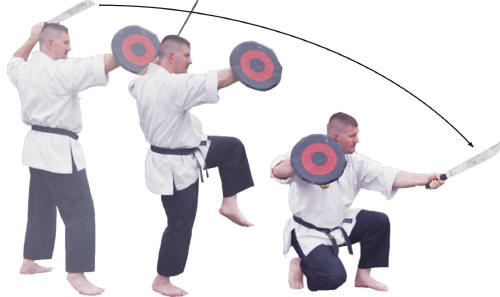
Kakushite uchi – squat slashing. Similar to previous one, as this is also an unexpected one. The point is in performing the sudden slash of the attacker’s leg in the middle of struggle, which according to the rule, the attacker doesn’t expect.
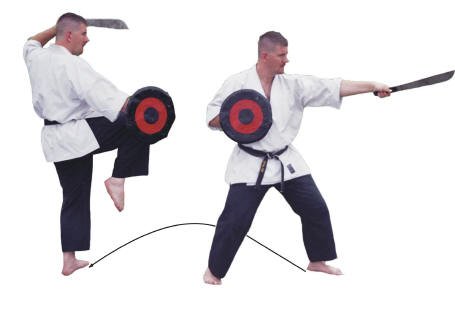
Kakushite tsuki – feint and stab. First, there is retreat by jumping backwards in crane position (tsuru dachi). Machete is in position so that opponent will think that I want to counter attack with upper slash (soto uchi), but then the direction is changing and a sudden stab with full step forward is performed.
The advanced use (Matayoshi no tinbei kata bunkai)
In the next few pages, I will show you the use of techniques from Shinbaru (Matayoshi) kata. There are only few techniques; actually, it is about one sequence repeating eight times in kata and a few extra ones. However, simplicity is what makes this combat system brutally efficient. Personally, I consider this kata “the pearl of Okinawan tradition“. I admit feeling slight awkwardness due to showing the use of technique. J For years, I have been keeping this only for advanced members of my dojo. Nevertheless, I think it is much better to share, so that other instructors can show to their student. This way tradition will flourish.
In my opinion, you cannot learn karate through books and that is why techniques shown here can only help as a reference for those who already have previous experience with this weapon. I will not deal with theory, as my opinion is that the use can be best understood through application. On the pictures, the attacker (tori) has white kimono, the one defending himself (uke) has black lower part of kimono.
Sequence 1 (uke-tsuki)
This is the basic combination. The attack is parried with the shield, followed by the counterattack by stabbing to body or neck of the attacker (tsuki).
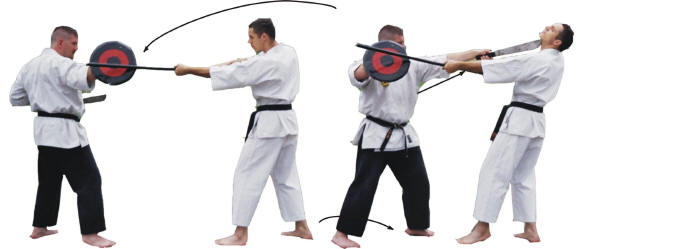
Sequence 2 (kakushite uchi)
Attacker stabs with the stick in the head.
This is an advanced combination. The first attack is blocked by moving away aside and the sudden slashing on the outside (gedan kakushite uchi) of the attacker’s legs. The point of the technique is in false swing and lifting the leg, which actually is a feint because the opponent is expecting an upper slash to the head, but instead a sudden squat and down slash is performed.
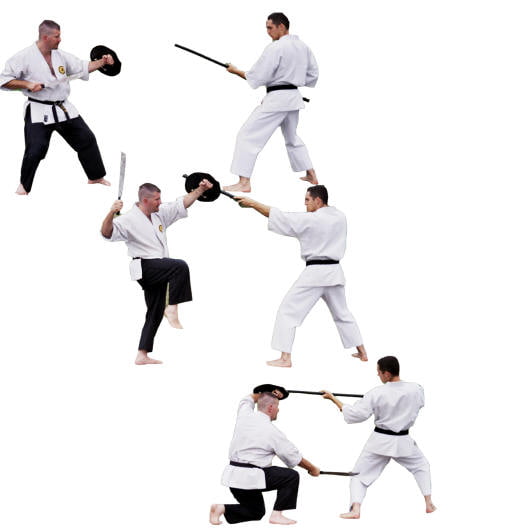

Sequence 3 (gedan uchi – soto uchi – uchi uchi – tsuki )
This is the most important combination in tinbei kata and I will call it “main sequence”. It is repeated eight times in different angles and manners. It represents a foundation of handling machete and shield. Actually, it is about four basic techniques of slashing and stabbing, that are previously explained, put in the combination:
TSUKI – GEDAN – UCHI – SOTO UCHI – UCHI UCHI – TSUKI
Techniques are performed continuously, so it is difficult to determine where one technique ends and where another one starts. This way, one learns how to perform the appropriate technique and continue the sequence in any position and moment. This method of practice is called renzoku and it can be found in many karate katas
First, I will explain the most obvious application of the main sequence and then one variety of this sequence. In its simplest form, all attacks are parried with machete and sequence is finished with stab (tsuki).
The attacker first tries hitting the legs with the stick which uke blocks with low slashing (2-gedan uchi); both of them continue preparing for the next technique (3). After that attacker aims to the head, uke parries by slashing on the outside (4-soto uchi). Right away, there is another swing to the head, but coming from the opposite side, which uke parries from the inner side (6-uchi uchi). The fourth attack uke stops, not using machete, but with shield and counters to the neck (8-tsuki).
 Make sure to remember that this is the simplest use. The attack could have started with some different technique and slashing techniques (uchi) can be used not only for blocking, but for counterattack, too. It will become clearer if you look at the next combination (pictures 4A – 7A). The techniques are the same, but the application is different.
Make sure to remember that this is the simplest use. The attack could have started with some different technique and slashing techniques (uchi) can be used not only for blocking, but for counterattack, too. It will become clearer if you look at the next combination (pictures 4A – 7A). The techniques are the same, but the application is different.
In this variation slashing techniques are used for offence. The opponent starts by attacking the head; uke parries with shield and slashes the attacker’s arm at the same time (4A). Right away, he follows by slashing the neck (6A) and stabbing (7A).
I hope this is not too complicated and that you can grasp the idea. It is obvious why this sequence appears so many times in kata. It represents the basic of manipulating with machete and shield.
 Sequence 4 (kakushite tsuki)
Sequence 4 (kakushite tsuki)
Attacker uses big swinging motion aimed to legs.
Uke retreats jumping back in “crane position” (tsuru dachi ). Shield is close to knee, machete is ready for upper slash.
Attacker misses legs and continues the swing, so that he is immediately ready to attack again or to parry my counter attack with machete.
Actually, this is the feint (kakushite). When the opponent attempt to parry machete, uke deflects his weapon with shield and instead of the slash, performs the stab to the attacker’s body or neck.
Sequence 5 (kakushite gedan tsuki)
Here is the analysis of the third kakushite technique, when the sudden roll over forward is used for shortening the distance. At first glance, this technique looks silly, but in real life situation, attacker gets confused and by the time he reacts, it is already late. After rolling over uke stays in squat position, blocks the opponent’s attack and stabs the attacker’s stomach or groin.
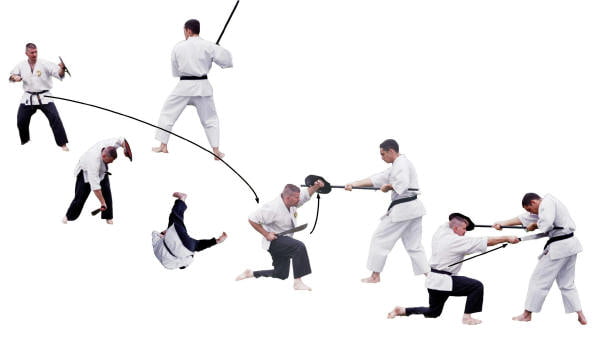
The Author and associates
The Author Milos Stanic (4.dan) promotes old okinawan empty hand and weapon traditions (shorin ryu karate & matayoshi kobudo) in Belgrade (Yugoslavia), teaching as professional instructor in Tsunami dojo. He is helping prospering popularity of traditional karate in southeast Europe by organizing karate demonstrations on all important martial art events. In addition, he is also trying to get global attention through Tsunami dojo website where he publishes articles and produces educational video material.
Assistants Milutinovic Mirko (1.dan) and Ivanovic Predrag (1. Dan) provided great support while making this article.
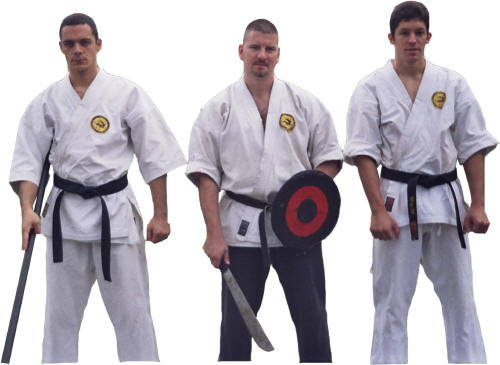
All copyrights reserved 2002. (The Author’s right are reserved, this article cannot be copied, published and cannot be used without the written permission of the author.)
Sources
- Bishop, M. (1999) Okinawan Karate: Teachers, Styles and Secret Techniques, 2nd Edition. Boston: Charles E. Tuttle, Co.
- Funakoshi G. (1976) Karatedo: My Way of Life. Tokyo: Kodansha International.
- Funakoshi G. (1988) Karatedo Nyumon. Tokyo: Kodansha International. Tr. by John Teramoto.
- McCarthy, P. (1999) Ancient Okinawan Martial Arts: Koryu Uchinadi, Vol. 2. Boston: Charles E. Tuttle,
- McCarthy, P. (1995) The Bible of Karate – Bubishi. Boston: Charles E. Tuttle, Co.
- Motobu C. (1932) Watashi no Toudijutsu (My Karate). Tokyo: Toudi Fukyukai.
- Nagamine S. (1986) Tales of Okinawa’s Great Karate and Sumo Masters
- Nagamine S. (1978) The Essence of Okinawan Karate-do, Charles E. Tuttle

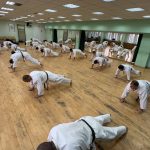

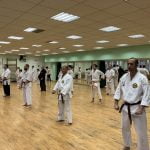
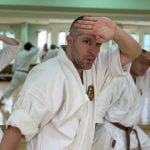

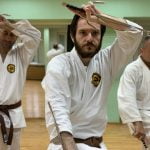
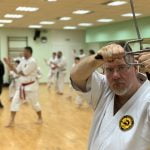
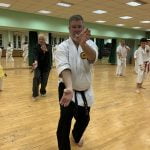
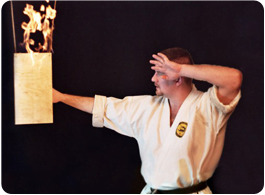
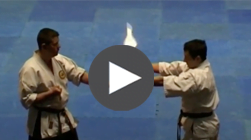
Thanks you very much for yours articles and your réflexion on karate